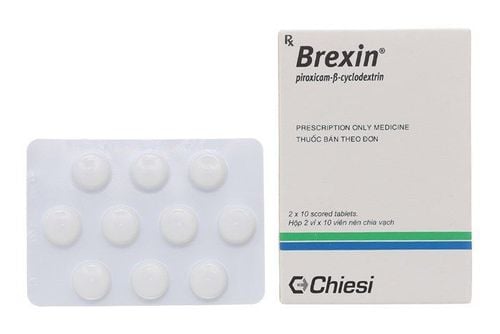This is an automatically translated article.
Vidmedrol is a steroid anti-inflammatory drug, which is very widely indicated in the treatment of symptoms caused by inflammatory reactions, due to immune disorders... However, along with its therapeutic uses The drug also has the potential for side effects if used incorrectly or abused. Let's learn about Vidmedol drug through the article below.
1. Uses of Vidmedol
Vidmedol drug is made in the form of tablets with the main active ingredient content of Methylprednisolone 4mg, 16mg. Many people wonder what is Vidmedol 4? Vidmedol 4 has the main active ingredient Methylprednisolone 4 mg, while Vidmedol 16 has the main ingredient Methylprednisolone 16 mg.
Methylprednisolone is a potent synthetic glucocorticoid that includes effects such as anti-inflammatory, potent immunosuppressive and anti-proliferative.
Methylprednisolone works to reduce inflammation by reducing the synthesis of inflammatory mediators such as PG, Thromboxan,... At the same time, inhibiting leukocyte adhesion to the damaged cell wall causes leukocytes to reach fewer areas. more damaged. From there, it helps to quickly reduce the symptoms of inflammation such as swelling, edema, pain. Like other forms of Glucocorticoid drugs, it also has immunosuppressive effects, reducing cell proliferation due to a decrease in cell protein synthesis, and a decrease in gene transcription.
This is a drug that is used in many clinical cases, but sometimes the use of the drug is easy to abuse and misuse leading to many consequences.
2. Indications and contraindications for taking Vidmedol
Vidmedol is indicated in the following cases:
Rheumatoid arthritis, including rheumatoid arthritis in children. This is the main drug used in the treatment of rheumatoid arthritis. Ankylosing spondylitis. Acute and subacute bursitis, synovitis of the joints. Nonspecific bursitis tendinitis. Post-traumatic osteoarthritis; Psoriatic arthritis ; inflammation of the supracondylar process. Acute gouty arthritis when other therapies fail or respond poorly. Collagen disease; systemic lupus erythematosus; systemic polymyositis. Low heart rate. Skin diseases such as bullous dermatitis Pemphigus; erythema multiforme; seborrheic dermatitis; exfoliative dermatitis; Psoriasis . Allergic diseases: Seasonal allergic rhinitis; allergic reaction; contact dermatitis; asthma ; allergic dermatitis. Eye diseases: Allergic conjunctivitis, optic neuritis, iridocyclitis, corneal ulceration. Respiratory diseases: Pneumonia, bronchitis, pharyngitis... Blood diseases: Hemolytic anemia; idiopathic thrombocytopenic purpura in children; secondary thrombocytopenic purpura in children; decreased erythrocyte count; congenital hypoplastic anemia. Tumor disease: Leukemia and lymphoma in children. Primary and secondary adrenal insufficiency: methylprednisolone can be used but is usually combined with a mineralocorticoid such as hydrocortisone or cortisol; Congenital adrenal hyperplasia; Non-purulent thyroiditis; Hypercalcemia in cancer. Other indications: Crohn's disease, nephrotic syndrome, exacerbation of multiple sclerosis (nervous system), tuberculous meningitis... Vidmedol is contraindicated in the following cases:
Patients with hypersensitivity sensitive to the components of the drug. Using live vaccines. Severe infections except in cases of septic shock and tuberculous meningitis. Severe skin lesions caused by viruses, fungi or tuberculosis. Do not use long-term with patients with history of peptic ulcer, severe osteoporosis, neuropsychiatric dysfunction.
3. Usage and dosage of Vidmedol
3.1. How to use The drug is used orally, taking the drug with water without chewing or crushing the tablet. Patients should be administered once daily in the morning after meals (8-9 hours) unless the dose is high. Once-daily treatment can help reduce side effects, or alternate day therapy can help reduce side effects. When high or long-term use is required, the dose should be reduced when stopping the drug to avoid the risk of adrenal insufficiency. If symptoms appear worse or do not improve, you should notify your doctor for appropriate adjustment.
3.2. Dosage The starting dose is 4-48 mg/day. This dose should be maintained and the dose adjusted until a satisfactory response is obtained. For long-term treatment, the lowest effective dose should be selected.
Sarcoid disease: Use at a dose of 0.8mg/kg/day. Use a low maintenance dose of about 8mg/day. Exacerbation of multiple sclerosis: Daily dose is 160mg, used continuously for 1 week, then reduce dose to 64mg per day and used for 1 month. Rheumatoid arthritis: In severe cases, use 16 mg. Systemic myositis: 48 mg/day. Systemic lupus erythematosus: Doses range from 16 to 100 mg depending on individual patient response. Allergic diseases: Dosage 16-40 mg per day. Asthma: Maximum dose of 64 mg / day or maximum 100 mg / therapy every other day. Blood and white blood cell disease: Use 16 to 100 mg depending on response. The above is a reference dose, the dose may also vary with many different conditions such as weight, disease status and drug tolerance.
4. Possible side effects when taking Vidmedol
In addition to the therapeutic effects, when taking the drug, you may encounter the following side effects:
Common: Abdominal pain above the navel, nosebleeds, hirsutism, increased blood sugar, joint pain, slow digestion, sleep problems, irritability, cataracts, glaucoma. Uncommon side effects: Vomiting, nausea, skin atrophy, hyperpigmentation, increased acne, dizziness, headache, hallucinations, psychosis, stomach ulcers. Other side effects: Causing Cushing's syndrome often with prolonged use, increasing blood glucose, causing female amenorrhea leading to infertility, increased blood pressure, hypersensitivity reactions, muscle weakness, osteoporosis. When experiencing any side effects, you should inform your doctor for reasonable advice. Side effects of Vidmedol are common when used for a long time, taking high doses, so if you adhere to the treatment, the risk of side effects will be reduced.
5. Notes when using Vidmedol
To use the drug safely and effectively, you need to keep a few things in mind:
This drug is a prescription drug, so do not arbitrarily use it without a doctor's prescription. You should inform your doctor about your medical history, history of allergies, and any medications you are taking. Caution for subjects: Patients with diabetes, hypertension, history of stomach ulcers, duodenal ulcers, children, pregnant and lactating women, people with osteoporosis, cirrhosis of the liver ... Do The drug has an immunosuppressive effect, so when you take it, there is a higher risk of infection. Effective precautions should be ensured to reduce the risk of infection. When taking the drug, you should never stop suddenly because it is dangerous. Use exactly as directed by your doctor. Do not vaccinate with this medicine, especially live vaccines. Possible drug interactions that increase the risk of side effects or reduce the main effect of the drug: Do not use concomitantly with cyclosporin; Phenobarbital, phenytoin, rifampin and diuretics that cause hypokalemia may reduce the effectiveness of the drug; The dose of antidiabetic drugs may need to be increased, because they raise blood sugar; Nonsteroidal anti-inflammatory drugs, if used concurrently, increase the risk of gastrointestinal side effects. Store the medicine in a cool, dry place. Avoid direct light and keep out of reach of children. Do not use if the medicine has expired or shows signs of deterioration. Hopefully, through the article you have had useful information about the use and note when using the drug. To ensure safety, use only when indicated and try to use a low dose, effective.
Please dial HOTLINE for more information or register for an appointment HERE. Download MyVinmec app to make appointments faster and to manage your bookings easily.













